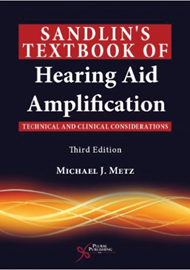This textbook is intended for graduate clinicians and scientists in audiology. It covers a broad range of topics over 20 chapters written by clinical and technical experts, most of whom are based in the US and Denmark, and the book unsurprisingly leans towards a US perspective.
It covers the subjects you would expect, such as speech processing and hearing aids, digital signal processing, real ear measures and questionnaires to measure hearing aid benefit, but there are also chapters on the psychology of individuals with a hearing impairment, cochlear implants and assistive technologies. There is good use of images and diagrams throughout the book, although the quality is occasionally variable. The chapters are mostly well written and self-test questions are provided so that readers can monitor their understanding of the content.
There is rather a lot of variation between the chapters in terms of the technical and clinical level, and the use of research evidence to support the content. Whilst some chapters appeared to be written for those new to hearing aids, others were highly technical and assumed a good understanding of terminology and basic concepts. A few topics occur in more than one chapter, and the chapter sequencing didn’t seem particularly intuitive; for example, I felt the chapter about moving from analogue to digital technology should come before the overview of digital signal processing in hearing aids, and detailed chapters on compression and directional microphone systems should come after this. When reading from cover to cover, the variation in level and the discontinuity in subject matter was rather difficult to adjust to, and I feel the book is more suitable for the reader who dips in and out of chapters as required. That said, it was sometimes difficult to tell from the title and chapter overviews whether the content was highly technical or clinically relevant.
I particularly liked: the chapter on compression, which is easy to read for newcomers and expert alike; the chapter on directional microphones, which is quite technical but interprets the research evidence very clearly with respect to clinical practice; and the inventory of hearing aid outcome measures, which is highly useful for clinicians and researchers in identifying tools to investigate fitting outcomes. There is a lot of detail on history of developments in hearing technology in some sections, but the relevance of this to current practice is not always made clear in the text. I was surprised that frequency lowering is only briefly mentioned and that little discussion about expectations of hearing aids was provided. I also felt that a section on communication strategies for hearing aid wearers would be helpful.
There is a lot of information in this book but whether or not it is useful very much depends on the expertise and needs of the reader. Given the price I think it is likely to find a home in university and hospital libraries, or perhaps in the bookshelf of a larger audiology department, rather than the personal bookshelf of researchers and clinicians.




